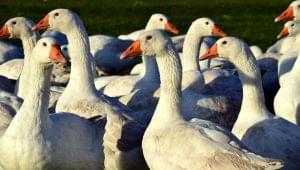This development also represents the renewal of agriculture
Historical opportunity, historical responsibility and historical difficulty – these three concepts characterize Hungarian agriculture today, we need to determine where the world’s agriculture is headed based on them, and where our country is located within it – stated Minister of Agriculture István Nagy in Nádudvar, OTP-Nagisz Zrt. on the handover of the turkey farm in Sõrehát.

István Nagy said that the poultry sector is the most competitive and at the same time the most concentrated livestock sector in our country, which also improves the foreign trade balance, in addition to domestic consumption, a significant export commodity base is formed (Photo: Pixabay)
The minister explained that the coronavirus epidemic drew our attention to the importance of food safety and food self-sufficiency, which was confirmed by the war raging in our neighborhood. The Ministry of Agriculture is working on how to provide even the smallest with the appropriate safety net, and in line with this, how to provide the largest with support that will push Hungarian agriculture forward. After all, if small producers are provided with such integrations in which they are protected, then the processing industry is also given the amount of raw materials with which they are able to fulfill their delivery obligations, and then there should be no problem with food self-sufficiency in Hungary – pointed out the head of the ministry. It is necessary to coordinate how everyone can find their place and role in agriculture, he added. Nagisz Zrt. is an agricultural enterprise with a history of 70 years, accumulating a lot of knowledge and experience during its operation. The investment in the Sőrehát turkey farm by OTP-NAGISZ also symbolizes the renewal of Hungarian agriculture. In the new turkey farm, they can use the most modern technology and produce the best quality, he pointed out.
The events affected not only agriculture, but also animal husbandry
István Nagy emphasized that, like other sectors, livestock breeding has been thoroughly tested in recent years. Despite the crisis caused by the Russian-Ukrainian war conflict, the large increase in energy and fuel prices, the bird flu and the historic drought, the Hungarian government continues to stand by livestock farmers. Very serious negotiations are underway with the financial sector in order to create a structure that will help everyone survive this drought period. He pointed out that it is necessary to rethink how livestock farmers can be provided with adequate feed even in times of drought, and agriculture must find new ways to solve this challenge. The head of the ministry also spoke about the fact that in the poultry sector, national or EU co-financed support can be used, for example, to compensate for additional animal welfare obligations and to prevent and combat animal diseases. In order to solve financing problems, several government-backed discount programs have been launched in recent years. In addition to all this, the Ministry of Agriculture was the first in the European Union to introduce the Crisis Insurance System in 2021, which is available to both animal breeders and plant growers. In order to deal with the market disruptions caused by the Russian-Ukrainian conflict, the Union decided to grant exceptional adaptation support to the producers of the agricultural sectors. Support is also available for the poultry sector, the minister listed.
AM
Related news
AM: Government helps farmers with a loan moratorium
🎧 Hallgasd a cikket: Lejátszás Szünet Folytatás Leállítás Nyelv: Auto…
Read more >More than 100 Hungarian farmers also demonstrated in Brussels
🎧 Hallgasd a cikket: Lejátszás Szünet Folytatás Leállítás Nyelv: Auto…
Read more >NAK: Domestic producers await customers with an ample supply of all pine species
🎧 Hallgasd a cikket: Lejátszás Szünet Folytatás Leállítás Nyelv: Auto…
Read more >Related news
New Year’s Eve: shortened opening hours in stores – general store closure on January 1
🎧 Hallgasd a cikket: Lejátszás Szünet Folytatás Leállítás Nyelv: Auto…
Read more >Tejföl is only a name for live flora: new categories for sour dairy products will be introduced from 2026
🎧 Hallgasd a cikket: Lejátszás Szünet Folytatás Leállítás Nyelv: Auto…
Read more >Sausage prices before New Year’s Eve: cheap entry, expensive premium – how big is the gap on the shelves?
🎧 Hallgasd a cikket: Lejátszás Szünet Folytatás Leállítás Nyelv: Auto…
Read more >






